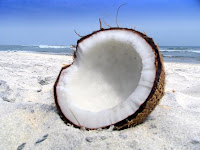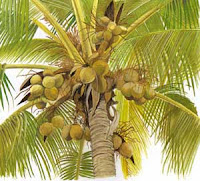Agriculture | Coconut | The coconut palm (Cocos nucifera), is a member of the family Arecaceae. It is the only accepted species in the genus Cocos. The term coconut can refer to the entire coconut palm, the seed, or the fruit, which is not a botanical nut. The spelling cocoanut is an old-fashioned form of the word.
Found across much of the tropics, the coconut is known for its great versatility as seen in the many domestic, commercial, and industrial uses of its different parts. Coconuts are part of the daily diet of many people. Its endosperm is known as the edible "flesh" of the coconut; when dried it is called copra. The oil and milk derived from it are commonly used in cooking and frying; coconut oil is also widely used in soaps and cosmetics. The clear liquid coconut water within is a refreshing drink and can be processed to create alcohol. The husks and leaves can be used as material to make a variety of products for furnishing and decorating. It also has cultural and religious significance in many societies that use it.
Cocos nucifera is a large palm, growing up to 30 meters (98 ft) tall, with pinnate leaves 4–6 meters (13–20 ft) long, and pinnae 60–90 cm long; old leaves break away cleanly, leaving the trunk smooth. Coconuts are generally classified into two general types: tall and dwarf. On very fertile land a tall coconut palm tree can yield up to 75 fruits per year, but more often yields less than 30 mainly due to poor cultural practices. In recent years, improvements in cultivation practices and breeding has produced coconut trees that can yield more.
Botanically the coconut fruit is a drupe, not a true nut. Like other fruits it has three layers: exocarp, mesocarp, and endocarp. The exocarp and mesocarp make up the husk of the coconut. Coconuts sold in the shops of non-tropical countries often have had the exocarp (outermost layer) removed. The mesocarp is composed of fibers called coir which have many traditional and commercial uses. The shell has three germination pores (stoma) or eyes that are clearly visible on its outside surface once the husk is removed.
A full-sized coconut weighs about 1.44 kilograms (3.2 lb). It takes around 6000 full-grown coconuts to produce a tonne of copra.
Within the shell is a single seed. When the seed germinates, the root (radicle) of its embryo pushes out through one of the eyes of the shell. The outermost layer of the seed, the testa, adheres to the inside of the shell. In a mature coconut, a thick albuminous endosperm adheres to the inside of the testa. This endosperm or meat is the white and fleshy edible part of the coconut. Although coconut meat contains less fat than many oilseeds and seeds such as almonds, it is noted for its high amount of medium-chain saturated fat. About 90% of the fat found in coconut meat is saturated, a proportion exceeding that of foods such as lard, butter, and tallow. There has been some debate as to whether or not the saturated fat in coconuts is healthier than other forms of saturated fat (see coconut oil). Like most nut meats, coconut meat contains less sugar and more protein than popular fruits such as bananas, apples and oranges. It is relatively high in minerals such as iron, phosphorus and zinc.
The endosperm surrounds a hollow interior space, filled with air and often a liquid referred to as coconut water (distinct from coconut milk). Immature coconuts are more likely to contain coconut water and less meat. They are often sold with a small portion of the husk cut away to allow access to the coconut water. Young coconuts used for coconut water are called tender coconuts. The water of a tender coconut is liquid endosperm. It is sweet (mild) with an aerated feel when cut fresh. Depending on its size a tender contains 300 to 1,000 ml of coconut water.
The meat in a green young coconut is softer and more gelatinous than that in a mature coconut (so much so that it is sometimes known as coconut jelly). When the coconut has ripened and the outer husk has turned brown, a few months later, it will fall from the palm of its own accord. At that time the endosperm has thickened and hardened, while the coconut water has become somewhat bitter.
When the coconut fruit is still green, the husk is very hard, but green coconuts only fall if they have been attacked by molds or other blights. By the time the coconut naturally falls, the husk has become brown, the coir has become drier and softer, and the coconut is less likely to cause damage when it drops, although there have been instances of coconuts falling from palms and injuring people, and claims of some fatalities. This was the subject of a paper published in 1984 that won the Ig Nobel Prize in 2001. Falling coconut deaths are often used as a comparison to shark attacks; the claim is often made that a person is more likely to be killed by a falling coconut than by a shark, yet such evidence as there is would suggest that the number of deaths due to falling coconuts is small.
When viewed on end, the endocarp and germination pores give the fruit the appearance of a coco (also Côca), a Portuguese word for a scary witch from Portuguese folklore, that used to be represented as a carved vegetable lantern, hence the name of the fruit. The specific name nucifera is Latin for nut-bearing.
A small number of writings about coconut mention the existence of the coconut pearl. This is generally considered a hoax. Professor Armstrong, of Palomar College, says "most eyewitness records of coconut pearls cited in the literature are secondhand accounts that were not observed by the authors of these articles. There are a few firsthand, published accounts of pearls observed inside coconuts, but these have been shown to be fraudulent. - Agriculture
Tags: coconut mojito recipe, coconut mojito, coconut oil cholesterol, coconut grove bank, jarrow coconut oil, coconut oil diabetes, coconut cholesterol, coconut rum recipes, coconut grove hotels, cholesterol in coconut, coconut and cholesterol, hotels coconut grove, coconut allergy, coconut rum, coconut oil acne, activated coconut carbon, coconut grove restaurants, coconut rum drink, coconut oil nutiva








No comments:
Post a Comment